Persian Carpet; From Imagination to Manifestation
The Persian carpet is a brilliant and glorious manifestation of the Iranian's rich culture and superior artistic sense.
The art of weaving carpets by hand starts with imagination and creativity in designing the pattern and comes alive with knotting threads to create a piece of art.
The Persian carpet might be the most well-known phrase that initially comes into one's mind when talking about Iran or Iranians. The Persian carpet is one of the oldest handicrafts in history and today is traded as precious and profitable commercial goods. Experts can estimate the price and value of a Persian carpet based on several factors, including the complexity of the patterns, material, the count of knots, the variety of colors in the design, and the age and origin of the carpet. Persian carpet has a deep-rooted history. The Pazyryk carpet, preserved in the Hermitage Museum in St. Petersburg, Russia, is an ancient witness of the Persian carpet's value and genuineness, dating back to more than 2500 years ago, according to archaeologists and specialists' findings. This article tries to answer some of the most crucial inquiries regarding the Persian carpet, such as its history, and the difference between a Persian rug and a Persian carpet, and also highlights the most influential factors which affect the price and value of a Persian carpet. At the end of this article, several helpful tips and cautions can be found on how to preserve and clean a Persian handmade carpet at its most desirable level in terms of appearance and overall quality.
Iranian Handmade Carpet
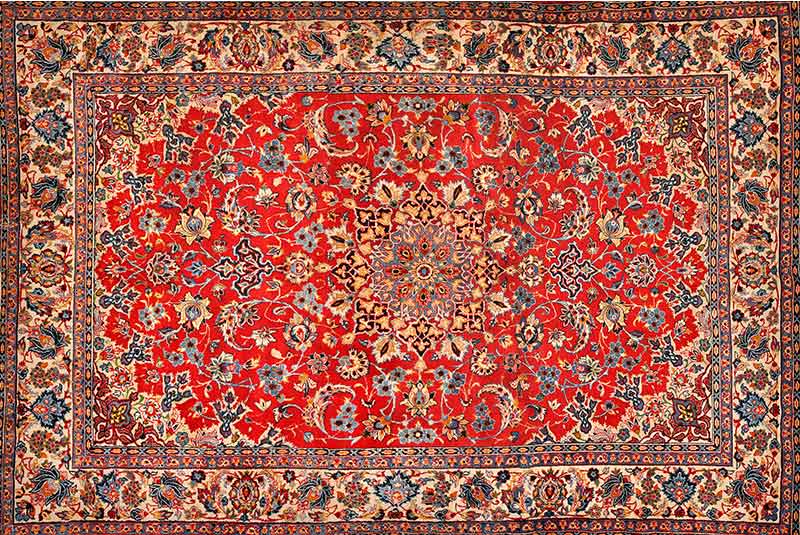
Iranian handmade carpets are significantly incomparable and unrivaled in the global market of handmade carpets. The quality and design of the Iranian handmade carpets are considerably outstanding compared to other handwoven carpets produced in other countries. Therefore, the Iranian handmade carpet is regarded as the most famous and valuable goods to be exported to foreign countries or purchased as souvenirs by individuals.
One of the characteristics of Iranian handmade carpets is their breathtaking diversity in terms of patterns, designs, fabric materials, and colors. Even the region where the carpet is woven would affect the characteristics of the carpet; for example, carpets that are woven in the western areas, such as Tabriz, Hamedan, and Bijar, are utterly different in style, color, and design from those carpets which are produced in central regions such as Kashan and Yazd.
Carpet weaving is a fruitful industry that is not limited to a specific area of Iran, and it is undertaken countrywide. All provinces weave carpets based on their own unique style and culture; however, some particular provinces are more prevalent in this industry, such as Eastern Azerbaijan, Isfahan, Fars, Markazi, Yazd, Khorasan Razavi, and South Khorasan. Handmade Iranian carpets form a noticeable share of the country's non-oil exports. The most famous destinations for exporting Iranian handmade carpets are Germany, Japan, and the United Arab Emirates; however, the exports are not limited to these countries and Persian handmade carpets have fans and customers in most European and Northern American countries as well.
| Find related articles here: Persian Art
Persian Carpet History

The Iranians were among the first nations to develop the original and ancient carpet-weaving art. They could brilliantly achieve a magnificent grade of perfection during centuries of designing and creating invaluable handmade Persian carpets, dating back to more than 2,500 years ago. Historians claim that the art of carpet weaving by hand was started in ancient Iran, which is also called Persia, by the nomadic tribes of Iran. This claim is backed by the Russian archaeologist's discovery of the Pazyryk carpet which experts estimated that it belongs to the fifth century BC. The Pazyryk carpet is an excellent illustration of carpet weaving art; this unique art and technique have been under constant change, it evolved and developed over centuries due to the various conditions caused by the different ruling empires in the Persian territory. Persian carpets are usually known for their symmetrical knots and the delicacy of their designs. In comparison, the design and texture of other handmade and oriental carpets generally express a lower meticulousness and delicacy due to their less accurate and asymmetrical knots, and also, they are woven according to more simple patterns in less radiant colors than Iranian carpets.
Furthermore, the quality of the thread or fabric used in the creation of the Persian carpet is significantly higher than the oriental carpets; usually, oriental carpets are made of lower-quality fabrics than Iranian ones. One of the most famous historical Persian carpets is the "Springtime of Khosrow”, which was woven by Iranians during the monarchy of Khosrow I, one of the Persian kings of Iran from 531 AD to 579 AD. Historians regard the Springtime of Khosrow carpet as the most precious handmade carpet of all time. This gigantic silk carpet had dimensions of 400' x 100’ with a weight of several tons.
The magnificence of the design and the level of professionalism in weaving the Persian carpet reached their peak during the Safavid Dynasty in the 16th century AD. Some of the most epic carpets in history that had been made in the Safavid era are preserved and displayed in the world's most outstanding museums, such as London's Victoria and Albert Museum and the Los Angeles County Museum.
Today, Iranian carpets and rugs are the most well-known handicrafts and souvenirs of Iran, representing and introducing Persia's rich and deep-rooted history and Iranian people's distinctive culture to the world's citizens.
Tip: Travelers who are interested in visiting the most glorious handmade Persian carpets will have the opportunity to visit The Carpet Museum of Iran during the Iranian World Treasures Tour and can ask for guidance from their tour leader on finding and visiting the Carpet Museum in Tehran.
The Difference Between a Persian Rug and a Persian Carpet

Usually, the words carpets and rugs are comprehended in a way that they refer to different meanings, while theoretically, both terms describe a cloth that is used to cover the floor. However, it should be mentioned that there are differences in terms of the dimensions of carpets and rugs. Both Persian rugs and Persian carpets are woven fabrics structured and made of knots with the same textures and techniques, and they are mainly used to cover the floor to provide a softer surface than the main floor. Furthermore, they are also used as a type of furniture to protect people from the cold surface of the floor during winter in their homes.
Moreover, some carpets and rugs are used as decorative elements in designing places either on the wall or on the floor due to their premium and stunning quality and design. Nevertheless, both Persian rugs and Persian carpets are thick, soft, and heavy, but still, they have slightly different features. The most significant difference is regarding their sizes; regularly, as it was explained carpets are bigger than rugs, likewise, this difference in terms of size applies to Persian carpets and rugs. To put it another way, usually, a carpet can cover the entire room or at least a significantly wide area of the floor in a room, wall to wall, on the contrary, a rug only covers a small area of a room due to its smaller size. Consequently, since the size of the rug is typically smaller than the carpet, it is more convenient to clean, wash or relocate.
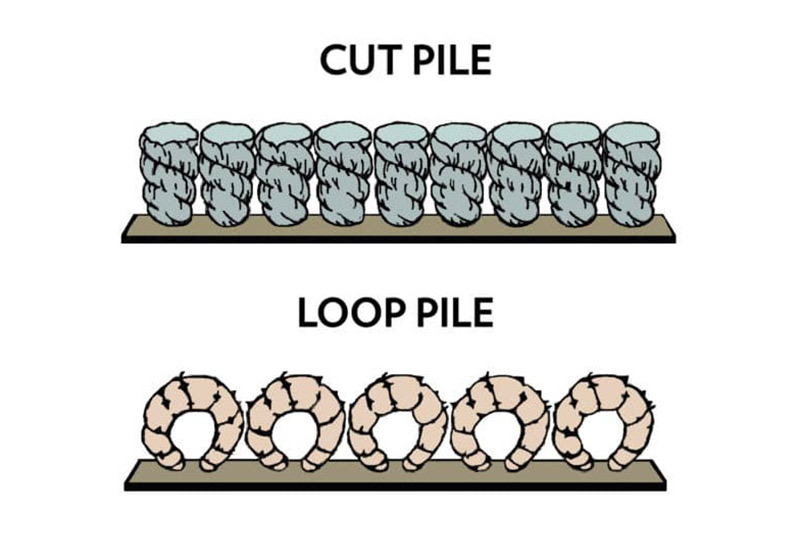
Iranian Carpet Texture
Iranian rugs and carpets fall into the cut pile category which refers to those types of carpets or rugs that, unlike the loop pile types, the weaver cuts the top surface of the pile that is formed by knotting the thread to the backing of the carpet or the rug. Cut pile carpets and rugs can be made of piles with different heights and thicknesses, accordingly cut pile carpets or rugs with higher piles provide a softer feeling while they can have downsides as well, such as difficulty in cleaning or vacuuming or even the trail of the vacuum cleaner might last on the piles after vacuuming the area.
The term “loop pile” which is also called “uncut pile” refers to carpets or rugs in which the knotted and looped thread is not cut into half on the surface of the carpet or rug. Loop pile carpets or rugs might not offer the same softness and artistic appearance as cut pile ones, but they also have their own notable advantages such as high durability and ease of cleaning which makes them the best options to cover the floor of public or high-traffic places, nevertheless, loop pile carpets and rugs also can be used in residential places, too.
Tip:
During the Eavar’s Nomadic tours, travelers who are interested in watching the hand-weaving process will have the opportunity to visit cities and places that are famous for weaving superior handmade Persian carpets and rugs. Moreover, travelers and guests of Eavar will be able to purchase their desired Iranian rug or carpet from the related bazaars during their visit, too.
Why Is the Iranian Carpet Famous?
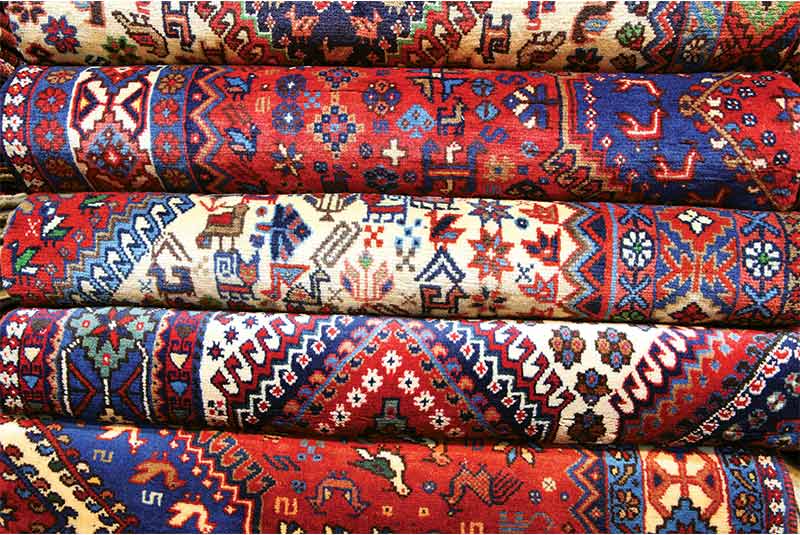
Experts discovered that several countries, such as Türkiye, Spain, China, Afghanistan, India, Egypt, Kazakhstan, and some parts of Europe such as Romania, have produced handmade carpets since ancient eras. However, Iran was the most prosperous country in developing and enhancing handwoven carpets' techniques, designs, and quality, among other competitors. This distinction and popularity are due to several reasons. The primary feature of Iranian handmade carpets which sets them apart from their rivals in the market is their significantly vibrant and diverse colors. Moreover, the patterns and plans on which the Persian carpets are woven are considerably more complex and detailed than carpets produced in other countries. Consequently, knotting and weaving Iranian handmade carpets take a notably more time than other handcrafted carpets made in other countries.
Artistry and Craftsmanship: The Making of Persian Carpets
The creation of a Persian carpet is a testament to the extraordinary artistry and craftsmanship that have been passed down through generations. At the heart of this intricate process lies a blend of traditional techniques, carefully selected materials, and a deep respect for the cultural legacy that each Persian carpet represents.
The art of hand-knotting is a cornerstone of Persian carpet craftsmanship. This method involves the painstaking process of tying individual knots around the warp threads, a technique that requires both skill and patience. These knots form the foundation of the carpet's design, dictating the density and intricate patterns that will ultimately define the finished piece. The mesmerizing geometry and intricate details that grace Persian carpets are a direct result of this meticulous hand-knotting process.
Materials play a pivotal role in the weaving of Persian carpets. The choice of materials directly influences the carpet's texture, appearance, and durability. Persian weavers often work with three primary materials: wool, silk, and cotton. Wool, sourced from local sheep, is the most commonly used material due to its resilience and versatility. Silk, known for its luxurious sheen, is reserved for more delicate and intricate designs. Cotton, on the other hand, is primarily used for the foundation and base of the carpet, providing stability and support.
The journey from concept to completion of a Persian carpet is an intricate one, with every step reflecting the dedication of the artisans involved. The design process begins with a skilled designer or "naksha-khan" who translates the vision into a detailed pattern. These patterns are meticulously drawn on graph paper, serving as guides for the weavers. The weaving process itself is a time-intensive endeavor, with weavers meticulously tying each knot according to the pattern. This intricate dance of color and form transforms raw materials into a symphony of art and tradition.
As the carpet nears completion, the attention to detail continues with the finishing touches. The carpet is carefully trimmed, washed, and sun-dried to enhance its colors and texture. The result is not merely a floor covering, but a true masterpiece that tells a story through its design, colors, and symbols.
Regional Diversity: Styles and Designs of Persian Carpets
The world of Persian carpets is a vibrant tapestry woven from the diverse threads of regional influences and artistic expressions. As vast as the landscapes of Iran itself, the designs of Persian carpets reflect the unique characteristics of different regions, capturing the essence of their cultures and histories.
Iran's geographical diversity has nurtured a rich variety of carpet designs, with each region infusing its creations with distinct flair.
- Tabriz, a historic carpet-weaving center, is known for its intricate floral patterns and detailed designs that often feature scenes from nature and royal courts. The city's carpets are characterized by their fine craftsmanship and use of contrasting colors, resulting in captivating compositions.
- Isfahan, with its storied history as a cultural hub, produces carpets that are renowned for their elegance and balance. Isfahan carpets often feature intricate medallion designs, intricate arabesques, and delicate motifs that evoke a sense of refined grandeur. These carpets are celebrated for their intricate craftsmanship and harmonious color palettes.
- Kashan, another influential carpet-weaving city, has a penchant for producing carpets with timeless designs and exquisite detailing. Here, you'll find carpets adorned with intricate floral motifs, graceful curvilinear patterns, and a blend of rich, harmonious colors. Kashan carpets embody a sense of sophistication and cultural heritage that has been passed down through generations.
- Kerman, situated in the southeast, is known for its diverse array of carpet designs. From intricate floral motifs to intricate central medallions, Kerman carpets boast a captivating variety. The city's carpets often showcase a dynamic interplay of colors, resulting in visually arresting pieces that exude warmth and charm.
The motifs, patterns, and color palettes found in Persian carpets are far from arbitrary; rather, they are imbued with unique cultural significance. Floral motifs, symbolizing growth and rebirth, pay homage to the natural beauty of Iran. Geometric patterns, drawing from Islamic art, reflect a deeper spiritual connection. Medallions represent unity and balance, while intricate borders tell stories of cultural journeys and interwoven histories.
Symbolism and Cultural Significance: Stories Woven into Carpets
Within the intricate designs of Persian carpets, a hidden world of symbolism and cultural narratives unfolds. Every motif, every pattern is a thread connecting the present to the past, carrying the weight of stories, beliefs, and the rich tapestry of Iran's cultural heritage.
- The "tree of life," a recurring motif in Persian carpets, embodies profound symbolism. Representing growth, connection, and continuity, this motif serves as a visual metaphor for the cycle of life and the enduring spirit of Iranian culture. The branches reach towards the heavens, while the roots delve deep into the earth, echoing the Persian philosophy of balance between the material and spiritual realms.
- Floral elements, another prevalent feature, are laden with meanings. Roses evoke love and beauty, while tulips symbolize renewal and rebirth. Jasmine flowers carry associations with purity and spiritual awakening. These flowers are meticulously woven into the fabric of Persian carpets, not only for their aesthetic appeal but also to convey messages of emotion and human experience.
- Geometric shapes, deeply rooted in Islamic art and mathematics, serve as vessels for cultural and spiritual expression. Repeating patterns like the endless knot embody eternity and the interconnectedness of all things. Intricate polygons speak to the precision of the cosmos and the harmony of creation. Such geometric designs remind viewers of the order inherent in the universe and encourage contemplation of the divine.
Beyond their aesthetic allure, Persian carpets have long been used as vehicles for storytelling. Weavers have ingeniously interwoven myths, legends, and historical events into their designs. Scenes of battles, courtly life, and traditional ceremonies are rendered in intricate detail, preserving the cultural memory of a people. This form of visual storytelling serves as a bridge between generations, allowing stories to be passed down through the ages without the need for written words.
Furthermore, Persian carpets carry within them the essence of belief systems. Islamic patterns and symbols, such as the "mihrab" (prayer niche), connect the material world to the spiritual realm, creating a sacred space for contemplation and prayer. Carpets have also been woven with Jewish and Zoroastrian symbols, revealing the diverse religious tapestry of Iran's history.
What Factors Determine the Price of a Persian Carpet

The value of a Persian carpet can fluctuate in a wide range of prices; Iranian carpets can be considerably expensive or have an affordable price based on the budget limitation of the buyer. The price of a handmade Persian rug or carpet can be affected by several different factors, and each of these factors can affect the cost and value of the carpet or rug separately. These factors include:
- The Persian carpet’s material: Usually, the material is the most fundamental factor in the pricing process, and the Persian carpet is not an exception when it comes to setting a price. To produce a handmade Iranian carpet, the quality of the raw material is the ultimate determinant in the pricing process. The required thread and fabric to make a handmade Persian carpet can be chosen among different options, including silk, wool, and cotton. Carpets made of silk are the most expensive types of carpets; however, the price of a silk carpet can be lower if the backing is not made of silk compared to a full silk carpet, in which both the backing fabric and piles are made of silk. Cotton carpets are cheaper than silk carpets and usually have a mid-range price. However, the most budget-friendly Persian carpets are made of wool.
To sum up, silk carpets are the most expensive and precious types of Iranian handmade carpets. However, the price will be estimated based on a few details, for instance, if all components of the carpet are made of silk the carpet will be more valuable and expensive as well, but if the silk pile is woven on the cotton or wool backing the price of the carpet will be lower compared to the full silk one, while it still keeps its artistic and silky appearance. Another reason that makes silk carpets significantly expensive and valuable is their extremely fine and detailed patterns and designs. Since silk is considerably thinner than wool and cotton, it facilitates the weaver to weave a softer, lighter, and more detailed carpet that can be easily folded.
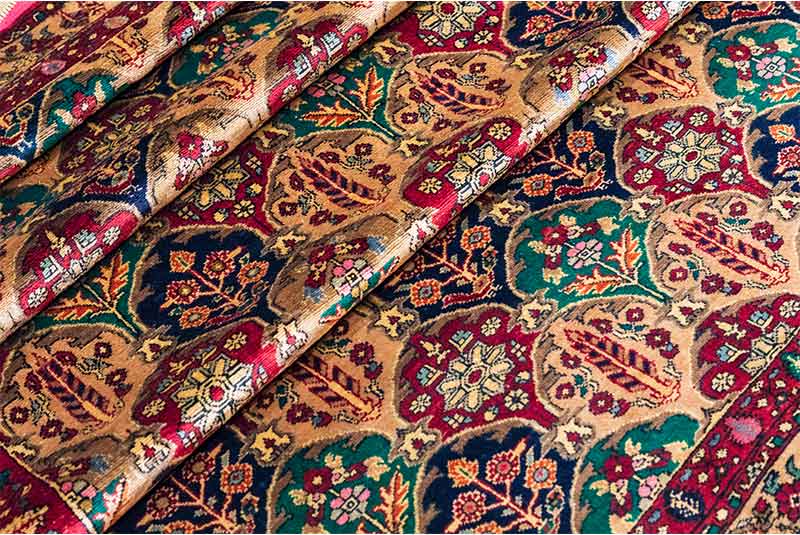
- Persian carpet design and the level of complexity of its pattern: The handmade Persian carpets with more complex, smaller, and more detailed patterns and designs take more time and effort from the weaver than weaving carpets with bolder, larger, and more simple patterns. Over and above, weaving complex carpets requires significantly more experience and attention to detail from the weaver, which directly affects the price of the carpet.
- The total number of knots: When a carpet has a considerably complex and detailed pattern, it means it has a significantly higher number of knots. Similarly, a handmade carpet with a higher count of knots will be woven in a longer time compared to a carpet with a lower number of knots, subsequently, it requires a higher labor effort and attention. Therefore, the count of knots is a significant determinant in pricing a handmade Persian carpet. Typically, the Persian carpet is made of approximately 300 knots per square inch; this number of knots in such a small area is considerably high. Accordingly, the lower the knots count, the lower the price will be.
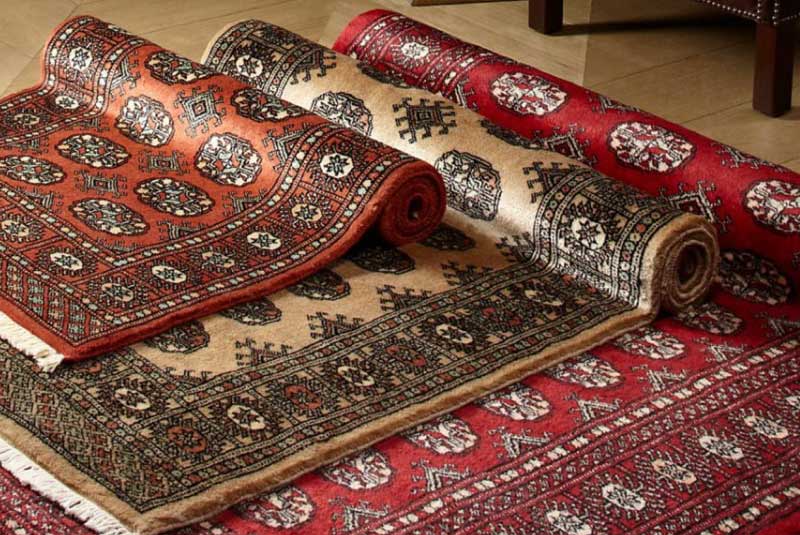
- The variety of used colors: A more colorful carpet made of vibrant and high-quality colors is more engaging and eye-catching. The number and quality of colors used in a handmade carpet are crucial determinants in pricing a Persian carpet. Using a considerably diverse range of colors requires superior skill and attention to detail in addition to the excessive time to spend on weaving a colorful carpet compared to a carpet consisting of a limited number of colors. As a result, a higher number of colors in a carpet will positively affect its price.
- The age and origin of the carpet: Similar to any other antique furniture, the carpets might be more valuable if their age is older than carpets with younger age. However, the carpet’s condition is also critical; an antique carpet with an ideal situation in terms of color and texture can have a significantly higher price depending on the uniqueness and rareness of the pattern and design of the carpet. Several regions in Iran produce handmade Persian carpets and rugs, but among all of these cities, Qom and Kashan are the most famous cities in the industry. Still, it depends on the desire and preference of the buyer to decide which pattern of the carpet is the best fit for their purpose.
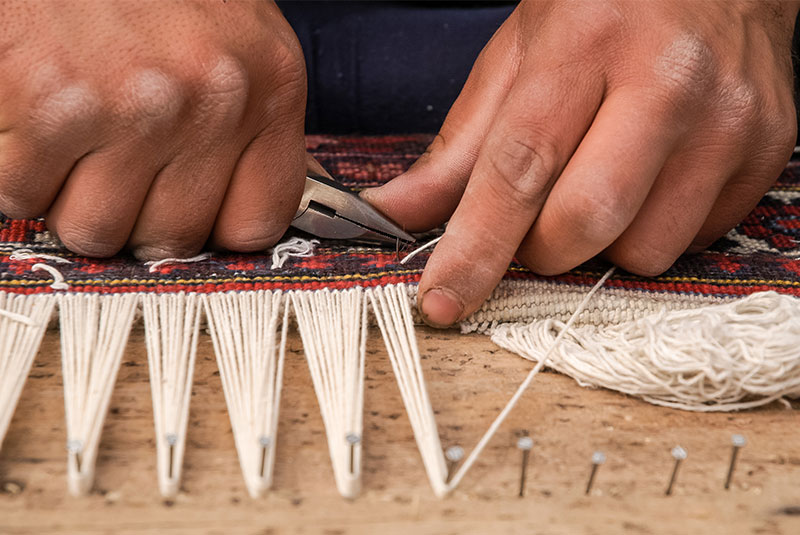
Economic and Social Impact: Persian Carpets in Global Trade
The allure of Persian carpets has transcended borders for centuries, making them not only cultural treasures but also economic commodities that have played a significant role in international trade. These woven masterpieces have contributed to Iran's economy, reflecting the intricate interplay between art, craftsmanship, and global commerce.
Throughout history, Persian carpets have been highly sought-after luxury items, coveted by collectors, nobles, and royalty across continents. This demand spurred a flourishing trade network that spanned the Silk Road and beyond, connecting the intricate designs of Persia with the tastes and preferences of distant lands. This historical trade not only enriched merchants but also facilitated cultural exchange, allowing the stories woven into each carpet to resonate across cultures.
In the modern era, the Persian carpet industry continues to hold economic importance for Iran. The craftsmanship and artistic excellence that define these carpets create a unique export product, generating significant revenue for the country. The industry provides employment opportunities for thousands of skilled artisans, from designers and dyers to weavers and finishers. The preservation of traditional carpet weaving techniques is not only a matter of cultural heritage but also a means of sustaining livelihoods.
However, the global market presents both challenges and opportunities for Persian carpet weavers. Mass production and imitation carpets have flooded the market, often undermining the value of authentic, handcrafted Persian carpets. The growth of online retail platforms and changing consumer preferences have also reshaped the way carpets are bought and sold. This has necessitated adaptability among carpet weavers, requiring them to find ways to remain relevant while staying true to their artistry.
Yet, within these challenges, lie opportunities. Efforts to protect the authenticity of Persian carpets, such as certification programs and labeling initiatives, have gained momentum. By educating consumers about the value of genuine Persian carpets, these efforts aim to preserve the integrity of the industry. Additionally, collaborations between designers and weavers, blending traditional techniques with contemporary designs, have opened doors to new markets and audiences.
The Persian Carpet Cleaning and Preserving Tips
Iranian handmade carpets or rugs require extra care and caution since they are made of organic and natural materials and dyes that are extremely sensitive. Experts suggest a few crucial tips regarding preserving the Persian handmade carpets' appearance and texture.
- Initially, the carpet must be laid on a dry, dust-free, and even surface; furthermore, it is also suggested that the carpet should not be put on top of another carpet.
- One of the most frequent reasons for damaging handmade carpets is the excess water that drains out from the plant's vases directly located on the carpets or even on the very close areas to the carpet, which leads to the rottenness of the texture or might cause stains on the carpet. Unfortunately, a rotten carpet might not be repairable or can only be revived by an expert's aid.
- Furthermore, the sharp and heavy furniture that has been put on the carpet constantly for a long time might cause noticeable indentations on the carpet's surface. If the indentation is recognized immediately, it can be revived by using a toothbrush; the indented area should be brushed in the opposite direction of the deformed piles until they turn back into their standard form. However, in more severe cases, indentations could be fixed by placing ice cubes on the indented area; during the procedure that the ice is melting, the deformed piles absorb the water and rise gradually to their standard form. Yet, in cases where the indentation is extremely old and deep, the deformation might not be reversed entirely.
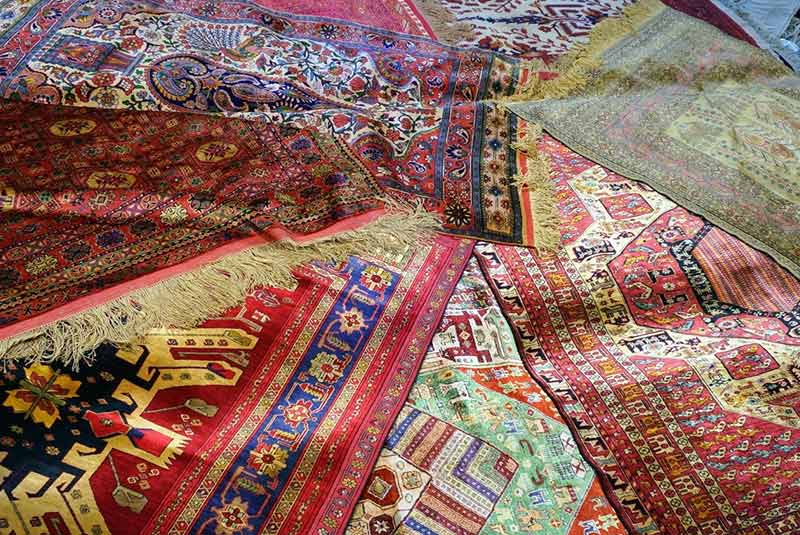
- To protect the carpet's colors from fading due to the direct exposure to the sunlight, the user should put a piece of textile on the carpet and rotate and relocate the carpet every six months.
- In places where the handmade carpet is kept, if the moisture index is significantly high or the air is not circulating regularly; it is suggested that the air circulation be facilitated by opening the doors and windows of the room monthly. If not possible or the place does not have any types of ventilation, the carpet must be taken out to the open spaces and be kept for at least an hour whenever possible.
- The regular vacuum of handmade carpets is crucial since the accumulated dust in the texture of the carpet will accelerate the carpet's rotting process; in addition to vacuuming the surfaces of the carpet, it is advised to vacuum the backing of the carpet once in a year.
- Last but not least, if the carpet is decided to be kept in storage for a long time, it is suggested to be rolled instead of folded and wrapped carefully in a plastic bag and sealed. But, before rolling in every layer, some dried tobacco or naphthalene pills should be put to protect the carpet from termites and clothes moths. Additionally, the storage space must have appropriate and constant air circulation.
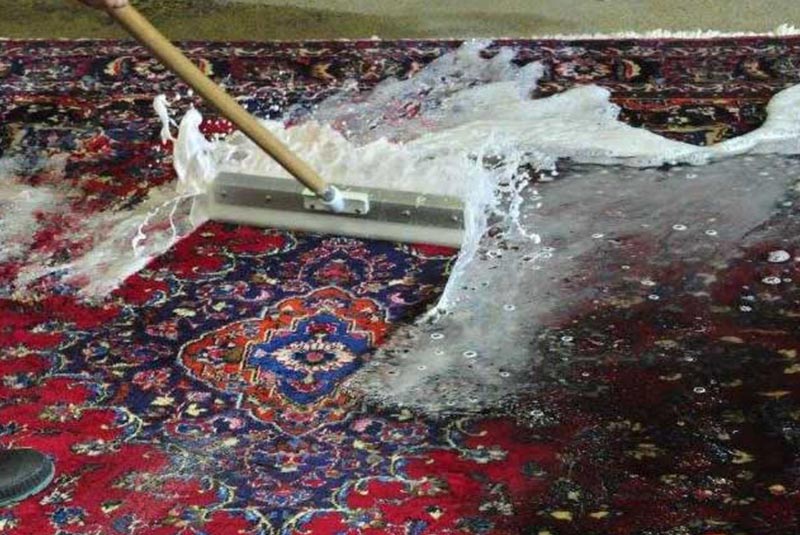
- The cleanness of the carpet is a crucial feature affecting the magnificence and attractiveness of its appearance; therefore, it is necessary to wash carpets every three to five years. But as handmade carpets are significantly sensitive to water, temperature, steam, excess pressure, and chemical cleaners, it is strongly recommended to hand the task over to experienced experts who do the washing of handmade carpets.
- In a situation in which it is unavoidable to wash handmade carpets at home, preferably, it is encouraged to clean only the stained area by using cold water and a soft cloth, or if needed, use a diluted mixture of suitable cleaners which are produced specifically for handmade carpets. Furthermore, a steam cleaner should never be used to clean a handmade carpet. Washing the handmade carpet with water and cleaners must be done by experienced experts since washing the handmade carpet at home or by inexperienced individuals might cause irreparable damage to the carpet.
Share your story!
Comment below and let us know about your Experience.
Your story inspires others!


Comment
Leave a Comment